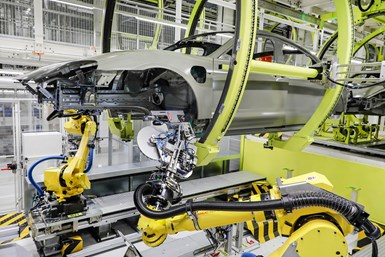Porsche Plugging Holes for Paint Access with Patches
Adhesive patches are replacing plugs in the production of the Taycan.

Robotically applying patches in the holes made in the structure of the Taycan. The holes are produced to allow access to cavities during the painting operation. These holes have traditionally been sealed after paint with plastic plugs. The adhesive patches are said to be superior. Photo Credit: Porsche
In producing the all-electric Porsche Taycan, it is necessary to have holes in the vehicle structure so as to allow body cavities to be accessible during the painting operation.
But then those holes must be plugged because otherwise there is the potential for corrosion to occur down the road.
Ordinarily, this is done by pushing plastic plugs into place—approximately 150 plugs per vehicle, or some 3,600 per shift. In some instances, it requires that the operator has to work under the vehicle and push in the plugs overhead.
What’s more, there are four different-sized holes, which means four different-sized plugs.
But the OEM, working with supplier Tesa SE, has developed what it claims is an all-new approach, with the Taycan to be the first-ever vehicle to have it: Sealing patches instead of plugs.
Process advantages
The patches are robotically installed, thereby eliminating the manual labor of plugging.
What’s more, there is a single-sized patch rather than four different sizes, thereby making inventory easier.
And while the plugs can extend up to 6 mm outside of the body, the patches are essentially flat, with a thickness of 1 mm.
At present, approximately two-thirds of the holes are being sealed with the patches.
Not what you wrap packages with
Dirk Paffe, Head of Planning for Paint Shop Processes at Porsche, the person responsible for implementing innovations in the painting operations, said, “It’s important not to confuse our adhesive solution with Tesa tape, which everyone knows from their office supplies.” (For those in the U.S., think in the context of that roll of adhesive tape on your desk from Scotch.)
The patches developed for this application form a strong bond. Paffe said, “Once the special Tesa sealing patches have been applied, they can only be detached again with a great deal of effort. They provide a durable solution that can also withstand the stresses caused by the motion of the vehicle, and last longer than the lifetime of the vehicle.”
The patches are being applied at the Porsche facility in Zuffenhausen. They will soon be used at the paint shop in the company’s Leipzig plant.
Related Content
-
Shedding Light on Surface Inspection
State-of-the-art reflector-based lighting system improves luminosity and ergonomics for surface inspection tasks while reducing energy usage.
-
Intumescent Coating Provides Up to 3 Hours of Fire Protection
PPG Steelguard 951 coating is designed to provide protection against fire and corrosion.
-
Products Finishing Reveals 2024 Qualifying Top Shops
PF reveals the qualifying shops in its annual Top Shops Benchmarking Survey — a program designed to offer shops insights into their overall performance in the industry.

.jpg;width=70;height=70;mode=crop)














